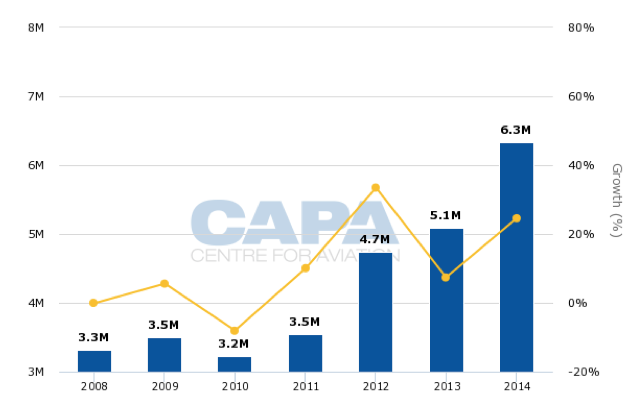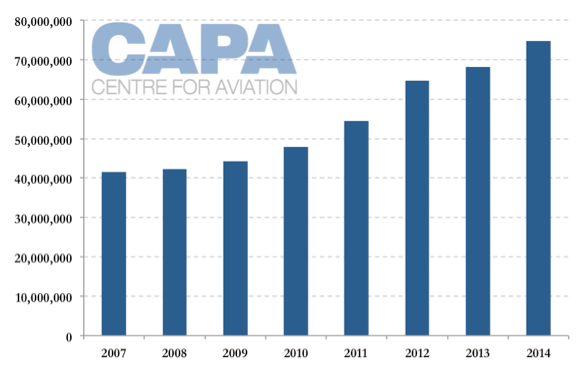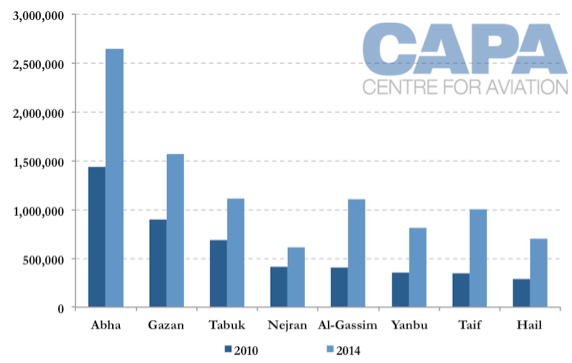New Madinah Mohammad Bin Abdulaziz Airport adds momentum to Saudi Airport privatisation
The gradual liberalisation and infrastructure improvement in the Saudi Arabian aviation sector continues to build momentum, with the opening of Madinah Mohammad Bin Abdulaziz Airport new privatised terminal at the beginning of Jul-2015.
The completion of the Madinah Airport project in western Saudi Arabia represents another milestone in the ongoing privatisation in Saudi's aviation sector. By looking to private partners for solutions, Saudi Arabia is accelerating the development of aviation infrastructure which has held back the growth of its airline sector, and of the wider economy.
The construction of new airports, alongside the development of existing facilities such as this new terminal, is needed for the country to support long-term plans to turn aviation into an economic driver in the kingdom. As oil prices remain depressed, the Saudi economy is increasingly looking to its non-oil sectors to ensure growth continues. Private participation will only take on an increasing level of importance, in aviation and elsewhere.
Much needed capacity for overcrowded Madinah Airport
The USD1.2 billion, three level development at Al Madinah (also known as Medina) encompasses nearly 157,000 sq m. The new terminal features 72 check-in counters, including 24 self check-in kiosks, as well as 26 are passport control counters at departure and arrival, more than doubling the amount of passengers the airport can process at any one time.
The facility has been designed to be modular, allowing the handling of greater passenger flows during peak travel periods, particularly for the high volume summer travel period, as well as the Hajj and Umrah pilgrimages.
Al Madinah is home to several important Islamic holy sites and is also less than 5 hours road journey from Mecca. In 2014, around 2.1 million pilgrims went on Hajj, with nearly 1.4 million of them arriving from outside of Saudi Arabia. The majority of these fly into Jeddah, but Al Madinah also experiences a traffic spike during Hajj.
The new terminal also features 16 aircraft stands and 20 remote apron, which nearly double the number of aircraft that can be handled simultaneously. The project also widened and extended Madinah Airport's taxiways and its runway, allowing it to very large aircraft such as the Boeing 747 and A380, a useful capacity for the pilgrimage periods.
The development increases annual passenger handling capacity at the airport to around 8 million. This is much needed: Madinah Airport handled 6.3 million passengers in 2014, well above nominal its design capacity for 4 million p/a. The resulting congestion led to frequent delays, particularly for pilgrim travellers.
Madinah International Airport passenger traffic
Subsequent developments will raise capacity to 18 million and then to 40 million passengers p/a. These will be phased in over the remainder of the 25-year build, operate and transfer contract for the airport, the first contract of its kind for Saudi Arabia, inside or outside the aviation sector.
Madinah Airport has experienced passenger traffic growth averaging just under 20% p/a for the past four years, thanks to growth in both domestic and international travel. By 2020, Madinah and Mecca combined are forecast to attract more than 20 million visitors p/a, around 11 million of which will be tourists, and the majority of the rest travelers for religious reasons.
Privatisation push should drive up capacity and standards
The Madinah development is also Saudi Arabia's first public private partnership (PPP) airport project. The Saudi Arabian General Authority for Civil Aviation (GACA) entrusted the development contract to the TIBAH Consortium, comprised of local companies Al Rajhi and Saudi Ogier and TAV Airports. The consortium has the right to operate the airport until 2037.
Outside of Madinah, Saudi GACA has already privatised the Hajj terminal at Jeddah International Airport. In addition, a management contract for Taif Airport is due to be finalised by the end of 2015.
Further airport privatisation projects are already in the works.
Al Mal Investment Company, the investment arm of the M.A. Kharafi Group of Kuwait, has been charged with developing the fast-growing Ha'il Regional Airport. The GACA has also confirmed that Riyadh International Airport is to be operated under another PPP in the future, although a firm date has not been announced.
Other airports are being considered for private sector management or development. This includes the remaining international airports, which handle nearly 85% of the country's passenger traffic between them.
Saudi Arabia is now emerging as a leader in the Middle East with its airport privatisation efforts. State operation remains the overwhelming model for airports in the Middle East, although many are run along corporate lines.
The smaller states of the Middle East have generally proved reluctant to turn over control of their major airports to private partners, primarily due to their importance to national development plans.
Some exceptions exist, most notably Jordan which awarded a 25-year build operate transfer concession in 2007 to Airport International Group for Amman International Airport.
The region's few other large states - such as Iran and Iran - have market features that have generally rendered them less than attractive for private sector investors. Iran's recent detente with the West may change this though, with Chinese and French investors already reportedly looking at airport privatisation opportunities in the country. Iraq too is seeking to attract foreign investment into its airport sector.
Saudi Arabia's situation is somewhat different, allowing to it adopt a different approach. With a population of more than 30 million and a land area of 2.15 million sq km, the country has the Middle East's second largest domestic air travel market (after Iran) and the third largest international travel market.
With the GACA operating 27 airports there is no single point of failure for it to be concerned with. As domestic and international traffic is diffused between its airports, the GACA also does not need to worry about a monopoly from a private operator.
The GACA has invited private partners in to lift the standards of its airports towards international standards for design, operating efficiency and passenger services. Its move to increasing privatisation also frees up finances and other resources, which the GACA can devote to its regional and smaller airports, which have suffered from a long-standing neglect.
Infrastructure development, liberalisation and privatisation contribute to growth
Traffic at Saudi Arabian airports exceeded 74 million in 2014.
Forecasts are that the wider Saudi Arabian air travel market will grow at around 5.5-6.5% p/a over then next five years, with traffic forecast to reach more than 100 million passengers before 2020. The Saudi travel market is benefitting from the country's rapid economic growth of the last few years, the expansion of domestic tourism markets and the country's own young, growing population that is exhibiting an an increasing propensity to travel.
Saudi Arabia's airports have received better than USD15 billion in investment in development over the past six years, to accommodate the ballooning international growth and also encourage domestic growth. The majority of funding has been dedicated to upgrading the four major international airports. The initial stages of these which have now been completed.
One of the final elements, the USD7 billion Jeddah International Airport project, is due for completion in mid-2016.
Saudi Arabian Airports passenger traffic: 2007-2014
The GACA has also moved to address the neglect of regional and domestic airports, improving accessibility in domestic air transport sector. The transformation has been impressive.
Growth rates at most of the domestic airports have reached double-digit levels. Five Saudi Arabian regional/domestic airports now handle more than one million passengers p/a, compared to just one with more than a million in 2010. Regional and provincial capitals like Yanbu and Ha'il are expected pass this milestone in the next two to three years.
Saudi domestic airports traffic growth: 2010 to 2014
Market liberalisation will ensure regional travel growth; Al Maha Airways, Saudi Gulf Airlines startups
In addition to the infrastructure improvements, the continued liberalisation up of the Saudi airline market will play a major part in ensuring the continued the expansion of regional travel. Two new airlines - Al Maha Airways and Saudi Gulf Airlines - have been granted start up approval, although their launch, originally slated for 2013 or early 2014, has been thwarted by repeated delays.
Both airlines are now due to launch operations towards the end of 2015, although issued with the kingdom's complicated regulatory regime and technical requirements mean that they have yet to formally secure their operating licenses.
The intention of both carriers is to initially focus on Saudi Arabia's major trunk markets, linking the business triangle of Jeddah, Dammam and Riyadh. However, they have also detailed plans to operate links from the major cities to second-tier regional destinations such as Abha, Gazan and Gassim, which should continue to feed the double-digit growth at these smaller airports.
Beyond the start-up phase, the new licensees have major ambitions for international short haul travel from the Saudi market. Al Maha plans to add 10-15 aircraft p/a into the market, building up to a fleet of around 50 aircraft at maturity. Saudi Gulf Airlines plans to launch with a fleet of four A320s and is due to start taking delivery of 16 new CS300 from late 2016. It has options for a further 10 CS300s.
Incumbent airlines adapt to respond to the new competition
The existing airlines in the market, flynas and Saudia, are adopting different tactics in the face of the new competition. flynas, firmly the junior player in Saudi Arabia, is increasingly devoting capacity to the domestic market, taking advantage of the suspension of the domestic fare cap and improved infrastructure at regional airports. With the failure of its low-cost long-haul business in 2014, flynas is now devoting more than than 70% of its seat capacity on domestic routes. This compares with just 50% during 2013.
Saudia, which still controls around 80% of total domestic capacity, had previously concentrated on improving its domestic operations, after considerable urging from the Saudi government. Following completion of the initial phase of its narrowbody aircraft fleet renewal, it has eased back this domestic focus slightly, slowing its domestic capacity growth in favour of the international market.
Saudia's share of seat capacity devoted to the domestic market has declined from just under 60% in 2012 to around 50% at present. According to the carrier, the combination of government established airfares, short sectors with ill-suited equipment and poor infrastructure meant that domestic flights lost money and hindered growth in international markets.
In response to this, the GACA plans to introduce a scheme to increase the amount of seats operated by local carriers to smaller domestic destinations.
Saudia will lead the programme and may receive some additional states support to the get the project off the ground. The GACA envisions using selected airports as regional gateways for onwards connections from international markets to smaller destinations across Saudi Arabia's northern and southern provinces. Ha'il Airport will be used to conduct a pilot for the scheme.
Investment and privatisation show welcome effects in Saudi Arabia
Saudi Arabia is approaching a point where its aviation infrastructure is sufficient to support its long planned for growth. The Madinah airport upgrade is meaningful, but it is just another incremental step in the development process.
The combination of airline liberalisation, airport privatisation and competition is beginning to transform the performance of what should be one of the Gulf's strongest aviation markets.
While this process has not been painless, nor has it yet achieved all that it has set out for, it is producing tangible benefits.
Saudi Arabia's passenger traffic growth is now consistently matching, if not bettering, the growth in the rest of the Middle East. With the heavy state investment complemented by growing private financing, the country's increasingly market-oriented competitive environment is witnessing an improvement in standards at both airlines and airports.
There is still ample room for improvement. Many of the smaller domestic and regional airports still suffer from outdated or decrepit infrastructure and more could be done to raise their performance. Domestic airline competition is still lacking, but 2016 and beyond should produce major changes. Saudia's decade-long and fitful privatisation process is approaching a conclusion and the two new licensees are expected to produce a double-digit bust in capacity growth for 2016.
Saudi Arabia has long been playing catch-up in the Gulf region's aviation transformation. The development of markets like the UAE and Qatar has been more cohesive and better managed, and the results have been more impressive.
However, the kingdom is now beginning to draw level with the other Gulf states. Steps like the privatisation of Medinah Airport build this momentum and will pay dividends for Saudi Arabia, as the kingdom continues to enhance competitiveness and efficiency in its aviation sector.


